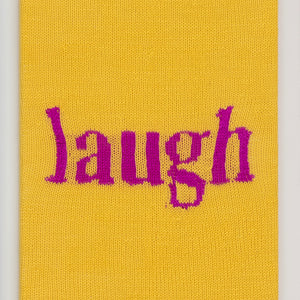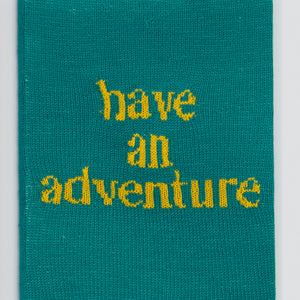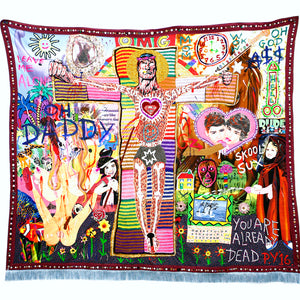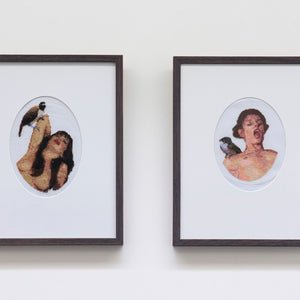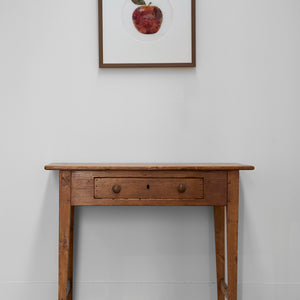Olga Cironis, Karla Dickens, Leah Emery, Michelle Hamer, Natayla Hughes, Kate Just, Hiromi Tango, Paul Yore MANY THREADS
29 June to 22 July 2023
Exhibition Statement
Many Threads celebrates the diversity and strength of contemporary textile art through the presentation of work by eight leading Australian textile artists - Olga Cironis, Karla Dickens, Leah Emery, Michelle Hamer, Natalya Hughes, Kate Just, Hiromi Tango, and Paul Yore.
The exhibition demonstrates the power of textile practice in communicating social, political, and cultural concerns. Each of the artists explore and interrogate the many threads of these themes, oscillating between traditional and non-traditional materials and techniques.
Artist Biographies
OLGA CIRONIS
The work of Olga Cironis contains layers of research, collected stories, muted voices and cultural heritage. Her work is psychologically loaded with meaning, provoking and seducing the viewer, navigating them through history and inviting them to question our social and environmental connections.
“Over a number of years, I collected domestic tools that in the past would have been looked after and maintained. Yet when found they were abandoned, wasted and broken. The tools began to fill my studio calling attention to themselves. They were tools with individual purpose and function. But a tool can also be a weapon and it is this dichotomy that I am interested in.
Moving and touching each tool as a new object I became conscious of human touch, physical and spiritual. The curvature of the organic wooden handles worn down by many hands and the contrasting cold of the straight surface and angles of the metal. Recalling stories of lives, mythology and silenced histories. Each tool was cleaned, handled and methodically wrapped in pieces of cut up blanket, stitched into place similar to ancient acts of embalming, hiding or exposing the shape of each object.”
“I drove past this rose bush lying on the road-side, ripped from the ground for next day’s garden pickup. It was already dry, from lack of water. Summer that year was hot and news of global warming warnings were on the radio, social media and TV every day. That day I was particularly restless and seeing the way this rosebush was discarded caught my attention, away from myself. It grieved me to see a rosebush, an archetypal symbol for love discarded as it was and so without thinking I did a u turn and drove back to where it lay. Carefully picking up the rosebush I put it in my car and drove directly to my studio.
The next morning was particularly hot, unable to sleep I left my partner and young daughter sleeping and drove to the studio to look and be inspired by the rosebush lying still on the concrete. Unlike the day before the dry carcass of the rosebush started to come alive for me. I could feel a sense of lightness, awe and love as I stood looking, feeling and listening. It was that space between the rosebush and the sound of my daughter’s breathing that I was wallowing in. I suddenly knew that I had to protect this rosebush as I protect my daughter. The two are interconnected. I closed the studio roller door and returned home to find my daughter waking into the new day.”
Olga Cironis is courtesy of Art Collective WA.
KARLA DICKENS
A Wiradjuri woman living in regional New South Wales, Karla Dickens is known for her often provocative reflections on Australian culture, past and present. Combining and repurposing material elements in unexpected ways, she takes on a three-tiered politic of marginalised identity, frequently tackling issues of race, gender and sexuality.
“I’m not a politician; I’m an artist, a storyteller. With my art, I talk about my personal experiences. I don’t set out to make political statements. I am political simply because I am who I am – a single mother, a lesbian, a First Australian.”
Karla Dickens is courtesy of STATION.
LEAH EMERY
Leah Emery is a Brisbane-based artist whose practice is concerned with presenting often difficult content with mirth and whimsy, all in the pursuit of storytelling. Her works serve as a protest to the cultural etiquette of withholding a healthy public access on topics surrounding gender identity, sex and intimacy despite being so quintessential to the human experience, as well as an objection to cultural tendencies to promote and reward an unhealthy manipulated, homogenised body aesthetic.
MICHELLE HAMER
The work ‘Imploding Explosions’, from the series ‘One Wall Two Jails’, focuses on language around border zones at the US-Mexican and Israeli-Palestinian borders. Hamer’s work maps contemporary social beliefs, fears and aspirations through ‘everyday’ language and place. The boundaries and barriers that she explores oscillate between fast and slow; past and present; personal and political and become markers of rarely captured but revealing moments in time. Her hand-stitched and drawn works occupy a space between 2D and 3D and are based on ‘found’ text and her own photographs. Hamer continues to be interested in being present in the complexity of in-between moments and the uncertainty of unresolved circumstances.
‘Imploding Explosions’ addresses the everydayness and language of fear within long-term conflict as Hamer continues to be interested in the difficulty of sitting with uncertainty, intersectionality and unresolved circumstances. The fear that has become engrained and a driving force concerns her the most and she found herself most drawn to moments that play towards it and/or reveal a glimpse of hope within it.
Hamer is interested in the way that language (including signage) can define space and how it can be used to explore how we negotiate boundaries and borders as individuals and as societies. Her artwork is a way of seeing and her world is defined by language, signage and spaces (and their in-between zones) and the literal and more nuanced readings of their juxtapositions.
Hamer's 'Wheel of Fortune' is a fun and disturbing slot machine style video artwork, made up of a series of hand stitched works created throughout 2020-2022 exploring the lottery of language we've been exposed to during a period of social upheaval; pandemic, climate change and intensified politics.
NATALYA HUGHES
Natalya Hughes' multidisciplinary practice is concerned with decorative and ornamental traditions and their associations with the feminine, the body and excess. Through painting, textiles, sculpture and installation, her recent bodies of work investigate the relationship between Modernist painters and their anonymous women subjects. Using the life and work of major 20th century male artists, Willem de Kooning and Ernst Ludwig Kirchner, as well as archival case studies of Sigmund Freud, Hughes seeks to examine society’s ‘problems’ with women and the fraught associations that have ultimately determined them.
Natalya Hughes is courtesy of Sullivan + Strumpf.
KATE JUST
Kate Just works across sculpture, installation, neon, textiles and photography to produce contemporary art works with feminist themes, but is best known for her inventive and political use of knitting. In addition to her solo practice, Just often works socially and collaboratively within communities to create large scale, public art projects that tackle significant social issues including sexual harassment and violence against women.
“Self Care Action Series consists of a series of forty brightly coloured, hand-knitted panels bearing texts relating to self-care actions. The series arose from my lived experience as a queer feminist, artist teacher, advocate, activist, and parent who has
dedicated significant time to generating social and political change through art. I began to consider the importance for artists and activists to find ways to sustain and care for oneself in difficult times, and formulated a list of texts/actions reflecting my own tools for self-care.
Each work is a simple prompt that I consider crucial for my own emotional survival and resilience and an invitation to others to imagine how they might prioritise caring for themselves. These are simple actions that are sometimes hard to do.
Though I initially made the signs to consider how to build emotional resilience, personal circumstances in my own life continued to shape and inform the work. In the two years leading up to the project my partner and I foster-adopted a second child from within our school community, struggled through two years of pandemic life, and then I entered menopause. And then, just as I started the series, my dearly loved father died. I was making the work at a time where I needed, more than ever, to revisit and sustain tools of self-care.
Beyond offering the means for taking care of myself as an artist and activist, the series has guided me and others around me with simple reminders how it is difficult but possible to survive grief, global upheaval, family stress, and life changes. As I share these works, I have noted that reminders to love and care for yourself are often welcome.”
HIROMI TANGO
Hiromi Tango is a Japanese Australian Artist who migrated to Australia in 1998 from Shikoku Island, Japan. She has been a resident of the Bundjalung Country, Tweed Heads, NSW since 2014.
For nearly two decades, Hiromi Tango has focused on the intersection between art and mental health. Drawing on her own experiences of anxiety, her installations and performances traverse the embodied self, the emotional terrain of our relationships with others, and the healing possibilities of art. She has collaborated with numerous scientists, health professionals and research institutions, exploring how various aspects of the art-making process can contribute to positive mental wellbeing.
“My heart is with the families and loved ones affected by the tragedy in Syria and Turkiye. We are many nations and religions but one heart of humanity. Please accept my sincere prayers for healing and hope.
One thousand wishes
souls united in prayer
for humanity
for healing and for
comfort in grieving I pray
with all of my heart”
Hiromi Tango is courtesy of Sullivan + Strumpf.
PAUL YORE
A prominent queer artist whose iconoclastic works engage with the histories of ritual, queer identity, popular culture, nationalism and neo-liberalism, Paul Yore was born in Naarm in 1987, completed his studies in painting, archaeology and anthropology at Monash University in 2010, and lives and works on stolen, unceded Gunaikurnai land. Yore’s garish yet playful works recast a vast array of found materials, images and texts into sexually and politically loaded tableaux, suggesting hybridity, contradictory meanings, or an overturning of stable categories altogether.
“From a very young age I was interested in ancient cultures, hieroglyphics, symbols—in signification itself. I still would say considerations of language and meaning-making is inherent to why and how I make art. The methodologies of anthropology and archaeology have certainly influenced my interest in collecting and examining waste products, but as fields of scientific inquiry, I do also think these disciplines are inherently problematic owing to their many biases and assumptions.”





























